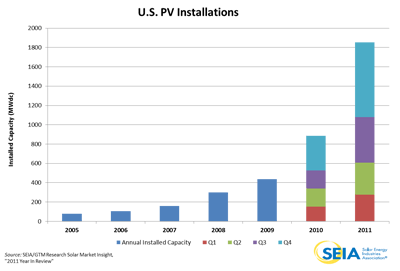The third quarter of 2011 was the best ever for the US solar industry, contributing to the unprecedented growth over the course of the entire year. These new records for installations and overall growth were supported by completions of large-scale utility projects, the strong residential market, and drops in the price of solar panels. During the third quarter of 2011:
- There were 449 megawatts of new solar electricity capacity installed.
- The residential market grew 21% over the same quarter in 2010.
- More solar electric capability was developed in the third quarter of 2011 than in all of 2009.
- 23 utility installations were connected totaling 200 MW.
- The amount of grid connected PV installed was 140% higher than the third quarter of 2010.
Among these promising statistics, which detail the gains made during the best quarter ever for the US solar industry, there are very real challenges also.
- The US Treasury’s successful 1603 Program (designed to reimburse businesses a portion of the cost of installing solar energy at a business or in a trade to aid in the production of income) is set to expire at the end of 2011. The industry is carefully watching the developments at the Federal level to see if this program will be extended. Additionally, developers have been busy completing or safe harboring existing solar installations to take advantage of the subsidies offered by the Treasury Department.
- The four largest solar markets in the US (Arizona, California, New Jersey, and Pennsylvania) saw a significant drop in new connected power that contributed to an overall 24% drop in the commercial market. These markets will likely participate in a slight “surge” during the first quarter of 2012 as projects eligible for the 1603 Program are completed. New, emerging commercial markets (Colorado, Hawaii, Massachusetts, Ohio, and Tennessee) offer reasonable promise that the commercial market will recover with additional opportunities in these states.
- The American market has seen a drop in panel prices of 40% in 2011 alone. As a stand-alone statistic this seems to be great news to report. However, these price drops are due, in part, to allegations that China is providing significant subsidies to Chinese solar companies which illegally dump their products in American markets. More affordable solar panels would be beneficial to American consumers, but not at the sake of American solar companies. There is currently an investigation underway into these allegations and a ruling could come as soon as next month.
A strong third quarter for the US solar industry points toward continued development, additional successful installations, and the growth of a pivotal renewable energy industry. Even amidst current challenges, the US solar industry remains highly beneficial to consumers, businesses, and our environment.

